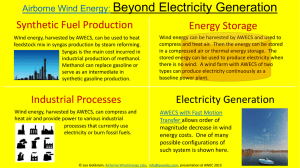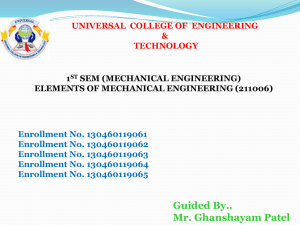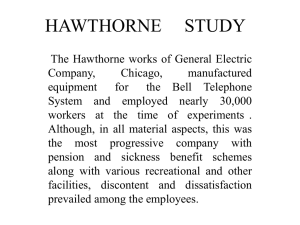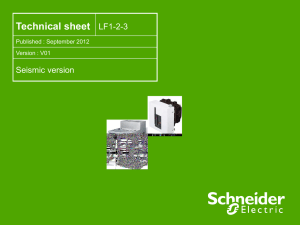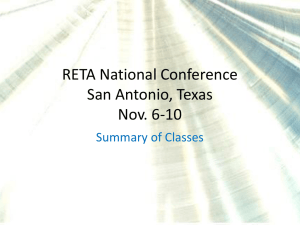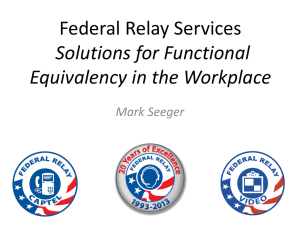E2 Subject1
advertisement
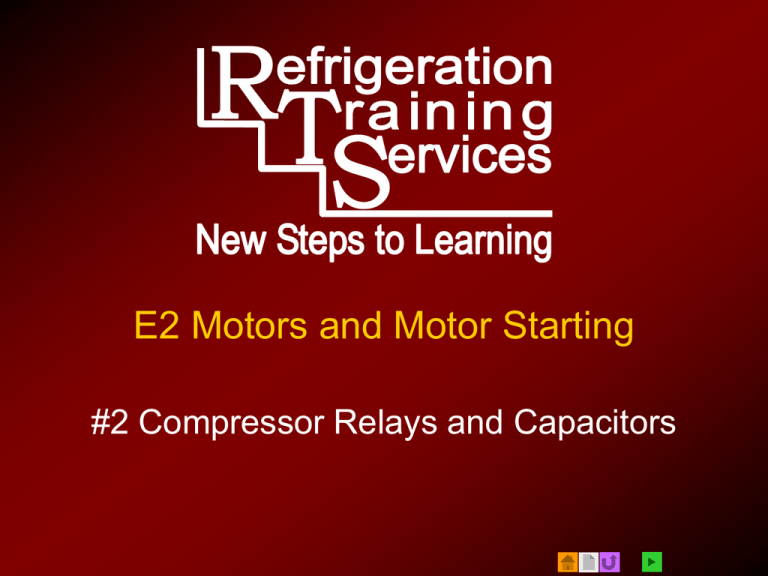
E2 Motors and Motor Starting #2 Compressor Relays and Capacitors Single Phase Compressor Starting • Single phase compressors have a start winding and a run winding © 2005 Refrigeration Training Services - E2#2 Compressor Relays and Capacitors v1.2 2 Split Phase Compressor Motor C S Ω Ω R VAC DC COM V/ © 2005 Refrigeration Training Services - E2#2 Compressor Relays and Capacitors v1.2 3 Starting a Split Phase Compressor • Power must first go to both the run winding and the start winding © 2005 Refrigeration Training Services - E2#2 Compressor Relays and Capacitors v1.2 4 Split-Phase Compressor Motor Starting Power is also needed to start C S START WINDING Once started, the start windings are removed from the circuit R RUN WINDING Power is needed for the motor to run LINE © 2005 Refrigeration Training Services - E2#2 Compressor Relays and Capacitors v1.2 5 Start Relays • A relay is used to energize the start winding • The same relay is also used to take the start winding out of the circuit • The next slide is a diagram of where start components are located in a compressor motor circuit © 2005 Refrigeration Training Services - E2#2 Compressor Relays and Capacitors v1.2 6 Diagram of Compressor Start Components For the motor to run, power is needed to Common and Run N L1 C S R Add torque with a Start Capacitor START RELAY For the motor to start, power is needed to the Start terminal. After start up, A Start Relay opens the circuit © 2005 Refrigeration Training Services - E2#2 Compressor Relays and Capacitors v1.2 7 Types of Compressor Starting • RSIR: Resistance start, induction run – Uses a start relay only • CSIR: Capacitor start, induction run – Uses a start relay and start capacitor • CSCR: Capacitor start, capacitor run – Uses a start relay and both start and run capacitors © 2005 Refrigeration Training Services - E2#2 Compressor Relays and Capacitors v1.2 8 Two Types of Starting Relays • Current Relays • Potential Relays © 2005 Refrigeration Training Services - E2#2 Compressor Relays and Capacitors v1.2 9 Current and Potential Relay © 2005 Refrigeration Training Services - E2#2 Compressor Relays and Capacitors v1.2 10 Current Relays • Used on compressors under one horsepower • Switch contacts are normally open (NO) • Relay coil energized by high starting current © 2005 Refrigeration Training Services - E2#2 Compressor Relays and Capacitors v1.2 11 Current Relay © 2005 Refrigeration Training Services - E2#2 Compressor Relays and Capacitors v1.2 12 Motor Amp Draw on Start up • Current relays respond to amp draw • Relay contacts close on high starting current • Relay contacts open as amperage drops Amperage Draw Motors draw high amps (LRA) on start up. 60A LRA Amperage drops as speed increases. 40A 20A 0A Start Up RLA 20% 40% 60% 80% 100% Motor Speed © 2005 Refrigeration Training Services - E2#2 Compressor Relays and Capacitors v1.2 13 Starting with a Current Relay • Current relays are used on refrigeration systems with fixed metering devices • When system pressures are equalized only a relay is needed to start the compressor © 2005 Refrigeration Training Services - E2#2 Compressor Relays and Capacitors v1.2 14 Split Phase Motor with Current Relay 1- High starting amps energize relay coil, close contacts 2- Line voltage goes to start windings S 3- Motor speed increases, amperage decreases, relay coil allows contacts to open C R START WINDING 4- Start Winding drops out 5- Motor continues to run, drawing normal current RUN WINDING S M CURRENT RELAY L POWER ON Original Diagram from Copeland Handbook LINE © 2005 Refrigeration Training Services - E2#2 Compressor Relays and Capacitors v1.2 15 How a Current Relay Works • The drawing on the next slide shows how the start winding is energized, then how it is taken out of the circuit © 2005 Refrigeration Training Services - E2#2 Compressor Relays and Capacitors v1.2 16 Current Relay Jumper wire Power In 1 2 S M Relay Coil To Start Terminal To Main (Run) Terminal © 2005 Refrigeration Training Services - E2#2 Compressor Relays and Capacitors v1.2 17 Energize Start and Run Windings Voltage ready for Start Winding Contacts close Voltage through coil High starting current increases coil magnetism Power to Start Winding Power to Main (RUN) Winding Plunger is pulled up © 2005 Refrigeration Training Services - E2#2 Compressor Relays and Capacitors v1.2 18 Start winding de-energized No voltage to Start Winding Plate falls, contacts open Power to Start Winding As motor speed increases, amperage falls Power to Main (RUN) Winding Plunger falls Compressor continues running © 2005 Refrigeration Training Services - E2#2 Compressor Relays and Capacitors v1.2 19 Adding a Start Capacitor • A refrigeration system with a TEV requires more starting torque • Adding a start capacitor in series with the start winding is all that is needed © 2005 Refrigeration Training Services - E2#2 Compressor Relays and Capacitors v1.2 20 Capacitor Start Induction Run Motor (CSIR) START CAPACITOR C S START WINDING R RUN WINDING S M CURRENT RELAY L LINE © 2005 Refrigeration Training Services - E2#2 Compressor Relays and Capacitors v1.2 21 Start Capacitors • They provide more phase shift to the start winding • Start capacitors are designed to be in the circuit for only a few seconds • A resistor quickly bleeds off capacitor charge to prevent excessive arcing across the relay contacts • Note: Always replace capacitors with the same microfarad rating (MFD or µF) and equal (or greater) volt amp capacity (VAC) © 2005 Refrigeration Training Services - E2#2 Compressor Relays and Capacitors v1.2 22 Start Capacitor Bleed Resistor 15,000 Ohms © 2005 Refrigeration Training Services - E2#2 Compressor Relays and Capacitors v1.2 23 Terminal box on a small compressor • A current relay plugs into the start and run terminals • The external overload is mounted inside the terminal box © 2005 Refrigeration Training Services - E2#2 Compressor Relays and Capacitors v1.2 24 Current Relay and Overload C S R © 2005 Refrigeration Training Services - E2#2 Compressor Relays and Capacitors v1.2 25 Current Relay and Overload C S R © 2005 Refrigeration Training Services - E2#2 Compressor Relays and Capacitors v1.2 26 Terminals - Current Relays - Overloads C Jumper Wire S R L1 N Remove jumper wire when installing start capacitor © 2005 Refrigeration Training Services - E2#2 Compressor Relays and Capacitors v1.2 27 Two-wire Overload • Single phase overloads are usually in the common wire • Its bimetal disk warps when heated • It responds to motor heat and amperage © 2005 Refrigeration Training Services - E2#2 Compressor Relays and Capacitors v1.2 28 2-wire bimetal overload L1 Power on 3 Load 1 2 Normal operating condition: 1-2 closed If the load draws high current, the heater from 2-3 becomes hot This warps bimetal 1-2, and opens the circuit between 2 and the Load © 2005 Refrigeration Training Services - E2#2 Compressor Relays and Capacitors v1.2 29 Potential Relays • Used for starting single phase compressors up to five horsepower • Contacts are normally closed (NC) • The relay coil is energized by Back EMF (electromotive force) generated in the start winding © 2005 Refrigeration Training Services - E2#2 Compressor Relays and Capacitors v1.2 30 Potential Relay – Top View “Dummy” terminal S 2 To start terminal From common terminal Contacts Solenoid Coil “Dummy” terminal 1 C 5 R From run terminal © 2005 Refrigeration Training Services - E2#2 Compressor Relays and Capacitors v1.2 31 Potential Relay Exposed 2 1 5 Normally Closed (NC) contacts between terminals 1 and 2 © 2005 Refrigeration Training Services - E2#2 Compressor Relays and Capacitors v1.2 Relay Coil 32 Potential Relay – Normal Position Normally closed contacts © 2005 Refrigeration Training Services - E2#2 Compressor Relays and Capacitors v1.2 Relay Coil De-energized 33 Potential Relay – After Start Up Contacts 1 to 2 are pulled open © 2005 Refrigeration Training Services - E2#2 Compressor Relays and Capacitors v1.2 Relay Coil energized 34 Potential Relays in Operation • The normally closed contacts allow full voltage to the start winding • The relay coil is energized • The contacts open • Back EMF keeps the coil energized, which keeps the contacts open © 2005 Refrigeration Training Services - E2#2 Compressor Relays and Capacitors v1.2 35 Potential Relay Capacitor Start Induction Run (CSIR) Motor 2 Back EMF keeps the coil energized S START WINDING 1 POTENTIAL RELAY START CAPACITOR 5 C R RUN WINDING LINE © 2005 Refrigeration Training Services - E2#2 Compressor Relays and Capacitors v1.2 36 Adding a Run Capacitor • A run capacitor is added to the starting circuit • When the potential relay opens the run cap stays in the circuit © 2005 Refrigeration Training Services - E2#2 Compressor Relays and Capacitors v1.2 37 Potential Relay Capacitor Start-Capacitor Run (CSCR) Motor 2 Back EMF keeps the coil energized 1 RUN CAPACITOR POTENTIAL RELAY START CAPACITOR 5 C S START WINDING The run capacitor stays in the circuit for greater motor efficiency R RUN WINDING LINE © 2005 Refrigeration Training Services - E2#2 Compressor Relays and Capacitors v1.2 38 Run Capacitors • When the compressor is running, a run capacitor provides partial voltage to the start winding • This lowers compressor amperage, increasing motor efficiency © 2005 Refrigeration Training Services - E2#2 Compressor Relays and Capacitors v1.2 39 Run Capacitors Old style New Style © 2005 Refrigeration Training Services - E2#2 Compressor Relays and Capacitors v1.2 40 Run Capacitors on PSC Compressors • No start relay is used on PSC motors • A run capacitor is permanently wired into the start windings • PSC compressors are used on fixed metering device air conditioning systems, where pressures equalize during the off cycle © 2005 Refrigeration Training Services - E2#2 Compressor Relays and Capacitors v1.2 41 Permanent Split Capacitor (PSC) Compressor Run Capacitor S Run Cap allows partial voltage to start winding C Start Winding R Run Winding Line © 2005 Refrigeration Training Services - E2#2 Compressor Relays and Capacitors v1.2 42 PSC* Compressor with Run Capacitor Compressor starts and runs efficiently LINE C S R Partial voltage through run cap Run Capacitor Energize start winding Compressor *Permanent Split Capacitor © 2005 Refrigeration Training Services - E2#2 Compressor Relays and Capacitors v1.2 43 PTC Relays • Positive Temperature Coefficient (PTC) solid state relays • The resistance of the ceramic disc increases with temperature © 2005 Refrigeration Training Services - E2#2 Compressor Relays and Capacitors v1.2 44 P.T.C. Relay Cutaway Wire spring holds disk and serves as a conductor Start Run Power from Run terminal Power to Start terminal Ceramic Disk © 2005 Refrigeration Training Services - E2#2 Compressor Relays and Capacitors v1.2 45 Location of the PTC Relay • The relay is wired in parallel to the run capacitor • It allows full voltage starting, then drops out of the circuit © 2005 Refrigeration Training Services - E2#2 Compressor Relays and Capacitors v1.2 46 PTC Relay and Run Capacitor PTC Relay Relay is wired in parallel with the run capacitor © 2005 Refrigeration Training Services - E2#2 Compressor Relays and Capacitors v1.2 47 PTC Relay in Operation • When cool, the disk allows full voltage to the start winding • The disk heats up quickly, stopping the flow of voltage • Power then takes the path of least resistance through the run cap to the start terminal © 2005 Refrigeration Training Services - E2#2 Compressor Relays and Capacitors v1.2 48 Start Assist with PTC* Relay PTC Relay Voltage stops when relay heats Starts with full voltage to start winding LINE C S R Runs with partial voltage through run cap Run Capacitor Compressor *Positive Temperature Coefficient © 2005 Refrigeration Training Services - E2#2 Compressor Relays and Capacitors v1.2 49 “Hard Start” Kits • Used on air conditioning compressors when compressor has trouble starting • Contains a solid state relay and start capacitor • Installed parallel to the run capacitor © 2005 Refrigeration Training Services - E2#2 Compressor Relays and Capacitors v1.2 50 Hard Start Kit (for PSC Compressor) PTC Relay Connect Leads to both sides of the RUN Capacitor Start Capacitor © 2005 Refrigeration Training Services - E2#2 Compressor Relays and Capacitors v1.2 51 Power to Hard Start Kit PTC Relay Full power plus start capacitor to start winding Start Capacitor © 2005 Refrigeration Training Services - E2#2 Compressor Relays and Capacitors v1.2 Incoming power on start up 52 Hard Start Kit Out of the Circuit PTC Relay PTC Relay heats up Current flow stops Start Capacitor Incoming power now goes through RUN cap © 2005 Refrigeration Training Services - E2#2 Compressor Relays and Capacitors v1.2 53 Hard Start Kit Added to PSC Compressor • The following slide shows the start kit in the starting circuit © 2005 Refrigeration Training Services - E2#2 Compressor Relays and Capacitors v1.2 54 PSC Compressor Start Assist Hard Start Kit (PTCR & Start Cap) Full Power plus Start cap to Start PTCR heats up, Stops current flow LINE C S R Current now goes through only the run cap. PSC Compressor Run Capacitor © 2005 Refrigeration Training Services - E2#2 Compressor Relays and Capacitors v1.2 55 Solid State Potential Relays • Use only if the OEM (Original Equipment Manufacturer) potential relay is not available • Use only as a temporary replacement of OEM potential relay © 2005 Refrigeration Training Services - E2#2 Compressor Relays and Capacitors v1.2 56 Electronic potential relay start kits Hard Start Kit Replacement Relays © 2005 Refrigeration Training Services - E2#2 Compressor Relays and Capacitors v1.2 57 Diagram of SS Potential Relay • OEM potential relay coils operate on Back EMF • Solid state potential relay coils operate on time to open the start circuit • The wiring hookup is basically the same as the original relay © 2005 Refrigeration Training Services - E2#2 Compressor Relays and Capacitors v1.2 58 Electronic Start Relays (Universal replacement relay PRO-90 by SUPCO) L1 Run Cap N O.L. Run Cap acts like a jumper wire C 2 5 R S Timer opens 1-2 1 4 6 Run cap provides efficient running © 2005 Refrigeration Training Services - E2#2 Compressor Relays and Capacitors v1.2 Start Cap 59 Solid State Current Relay Kits • Useful on small hermetic refrigeration compressors • Replaces the current relay and capacitor © 2005 Refrigeration Training Services - E2#2 Compressor Relays and Capacitors v1.2 60 Start Kit for Small Refrigeration Units PTC Relay Incoming Power Start Capacitor To START terminal © 2005 Refrigeration Training Services - E2#2 Compressor Relays and Capacitors v1.2 To RUN terminal 61 Installing a Start Kit • The following slide shows how the start kit is hooked up to the compressor • Use the original overload, NEVER jump out the overload Note: This kit can be used even if the original compressor did not have a start capacitor © 2005 Refrigeration Training Services - E2#2 Compressor Relays and Capacitors v1.2 62 Replacing a Start Relay with a Start Kit Connect L1 & Run Remove Relay L1 L1 N Use existing overload Connect to Start PTC Relay & Start Capacitor Start Compressor © 2005 Refrigeration Training Services - E2#2 Compressor Relays and Capacitors v1.2 63 Start Kit with Overload • Some kits include an overload • This kit can replace all the starting components at one time © 2005 Refrigeration Training Services - E2#2 Compressor Relays and Capacitors v1.2 64 Electronic current relay start kit Power Leads Terminal connections for Run, Start, & Common © 2005 Refrigeration Training Services - E2#2 Compressor Relays and Capacitors v1.2 65 Inside a “3 in 1” Kit C S R N L1 OVERLOAD PTCR Start Capacitor © 2005 Refrigeration Training Services - E2#2 Compressor Relays and Capacitors v1.2 66 © 2005 Refrigeration Training Services - E2#2 Compressor Relays and Capacitors v1.2 67
